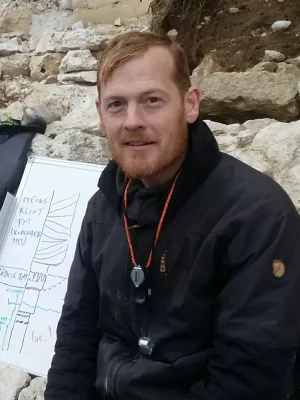
Mikael Calner
Professor

Transgressive oolites onlapping a Silurian rocky shoreline unconformity, Gotland, Sweden.
Författare
Summary, in English
Stratigraphical relationships, facies and petrographical evidences define a rocky shoreline in the Late Wenlock of Gotland. The major facies-elements forming the rocky shoreline are 1) several subaerially exposed reefs, which were eroded during falling base-level and which form the topography, and 2), onlap of oolite grainstones which were deposited during the subsequent rise of the base-level. Five localities along the rocky shoreline are discussed in detail here, viz., Svalings 1 where the unconformable boundary is accessible, and Bara 1-4 where the petrography of the onlapping oolite has been studied. A regression at the end of the latest Cyrtograptus lundgreni Biozone resulted in emersion of parts of the Gotland carbonate platform. Erosion during the short time interval of maximum lowstand (top C. lundgreni Biozone) caused the topography of this rocky shoreline and resulted in truncations, corrosion and vadose silt in the exposed reefs. The following parvus-nassa Biozone starts with the transgressive Bara Oolite Member (lowermost Halla Formation) which onlaps the southern flanks of the youngest reef generation of the Slite Group. The rocky shoreline can be traced for 11 km striking SW-NE. Calculated base-level for the erosion is situated more than 16 metres below the top of the highest preserved part of one Slite reef, indicating the probable minimum magnitude of the sea-level drop. Detailed petrographic work on the onlapping oolite is consistent with the interpretation that it was formed in the tidal zone of the shores bordering the palaeocoast. The Slite Rocky Shoreline Unconformity (SRSU) is herein considered as the platform-proximal equivalent to the sequence boundary separating the regressive Fröjel Formation and the transgressive Bara Oolite Member (lowermost Halla Formation) in the Klintehamn area on western Gotland. The rocky shoreline development is taken as the most reliable evidence of a rapid regressive-transgressive cycle in the mid-Homerian of Gotland.
Avdelning/ar
- Berggrundsgeologi
Publiceringsår
1999
Språk
Engelska
Sidor
91-100
Publikation/Tidskrift/Serie
GFF
Volym
121
Issue
2
Länkar
Dokumenttyp
Artikel i tidskrift
Förlag
Taylor & Francis
Ämne
- Geology
Nyckelord
- sea-level change
- palaeotopography
- Silurian
- oolite
Status
Published
ISBN/ISSN/Övrigt
- ISSN: 2000-0863

